Golf enthusiasts understand the significance of putting in shaping a successful game. When weather conditions or time constraints hinder outdoor practice, an indoor putting green becomes an invaluable asset. In this extensive guide, we’ll explore the world of indoor putting greens, providing insights on how to compare and shop for the perfect setup to enhance your putting skills and elevate your golfing experience within the comfort of your home.

A Guide to Indoor Putting Greens
Understanding Indoor Putting Greens
1. Types of Indoor Putting Greens:
- Modular Greens: These are modular systems that allow you to assemble a putting green in various configurations. They often come with interlocking panels and synthetic turf.
- Roll-Out Greens: Convenient and space-efficient, roll-out greens are pre-made surfaces that can be easily laid out on a flat floor. They vary in length and speed.
- Custom-Built Greens: For those seeking a tailor-made experience, custom-built greens are designed to fit specific spaces. They offer flexibility in size, shape, and green speed.
All types of indoor putting greens
2. Key Components:
- Surface Material: The material used for the putting surface significantly influences the ball’s roll. Quality synthetic turfs with consistent and smooth surfaces are common choices.
- Base Material: A sturdy and flat base is crucial for stability. Some setups use foam backing for a softer feel, while others rely on more rigid materials for a firmer foundation.
- Speed and Stimp Rating: The desired speed of the putting surface is subjective. The Stimp rating, measuring green speed, helps in understanding how the ball will roll.

3. Size and Space Considerations:
- Assess the available space in your home. Roll-out greens are suitable for smaller spaces, while modular or custom-built greens offer versatility for larger areas. Consider the dimensions that align with your practice goals.
We may earn a commission, at no additional cost to you.
Comparing Indoor Putting Greens
1. Quality of Materials:
- Surface Durability: Look for durable synthetic turf that mimics the feel of a real green. Check for UV resistance to ensure longevity.
- Base Stability: Assess the stability of the base material. It should provide a consistent and level surface for a realistic putting experience.

2. Ball Roll and Stimp Rating:
- Consistency: A quality indoor putting green offers consistent ball roll. Check product reviews and specifications for insights into the green’s performance.
- Stimp Rating: Greens with a known Stimp rating provide an indication of the speed. Consider your preference, whether it’s a slower, more forgiving green or a faster, challenging one.

3. Ease of Installation:
- Modular Greens: Evaluate the ease of assembly and disassembly. Modular systems should offer straightforward installation without the need for specialized tools.
- Roll-Out Greens: Check for user-friendly features like non-slip backing and easy storage options.
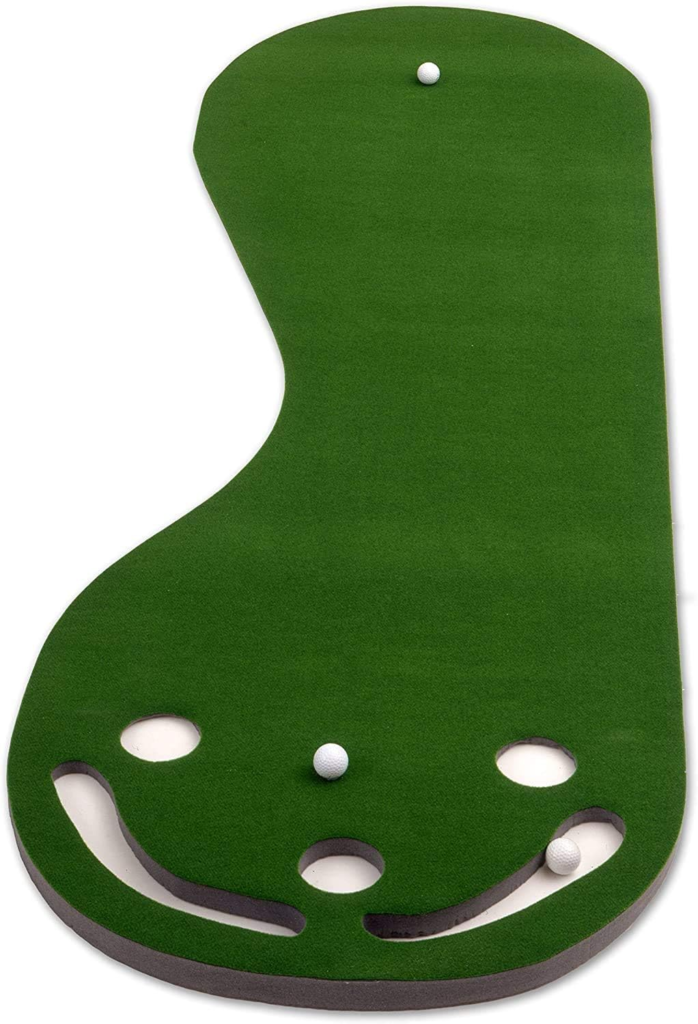
4. Portability:
- Storage Options: Consider the ease of storage, especially if you have limited space. Roll-out greens should be easily rolled up and stored, while modular greens should disassemble for compact storage.
We may earn a commission, at no additional cost to you.
5. Customization Options:
- Modular Greens: If opting for a modular system, explore customization options in terms of shape and size. Some systems allow you to change configurations for added variety.
- Custom-Built Greens: For those seeking a tailored experience, inquire about customization options in terms of size, contouring, and even the inclusion of hazards.
6. Cost and Value:
- Initial Investment: Compare the cost of different indoor putting greens. Consider your budget and the features that align with your practice needs.
- Long-Term Durability: Assess the long-term value by considering the durability of materials. A slightly higher initial investment may be justified by a more robust and long-lasting product.
7. Customer Reviews:
- Explore reviews and testimonials from other golfers who have used the indoor putting green you’re considering. Real-world experiences provide valuable insights into performance, durability, and overall satisfaction.
Shopping Tips for Indoor Putting Greens
1. Define Your Practice Goals:
- Understand your practice objectives. Whether you’re focusing on refining your short game or overall putting skills, knowing your goals will guide your choice of indoor putting green.
2. Measure Your Space:
- Take accurate measurements of the available space in your home. This will help you determine the size and configuration that best fits your practice area.
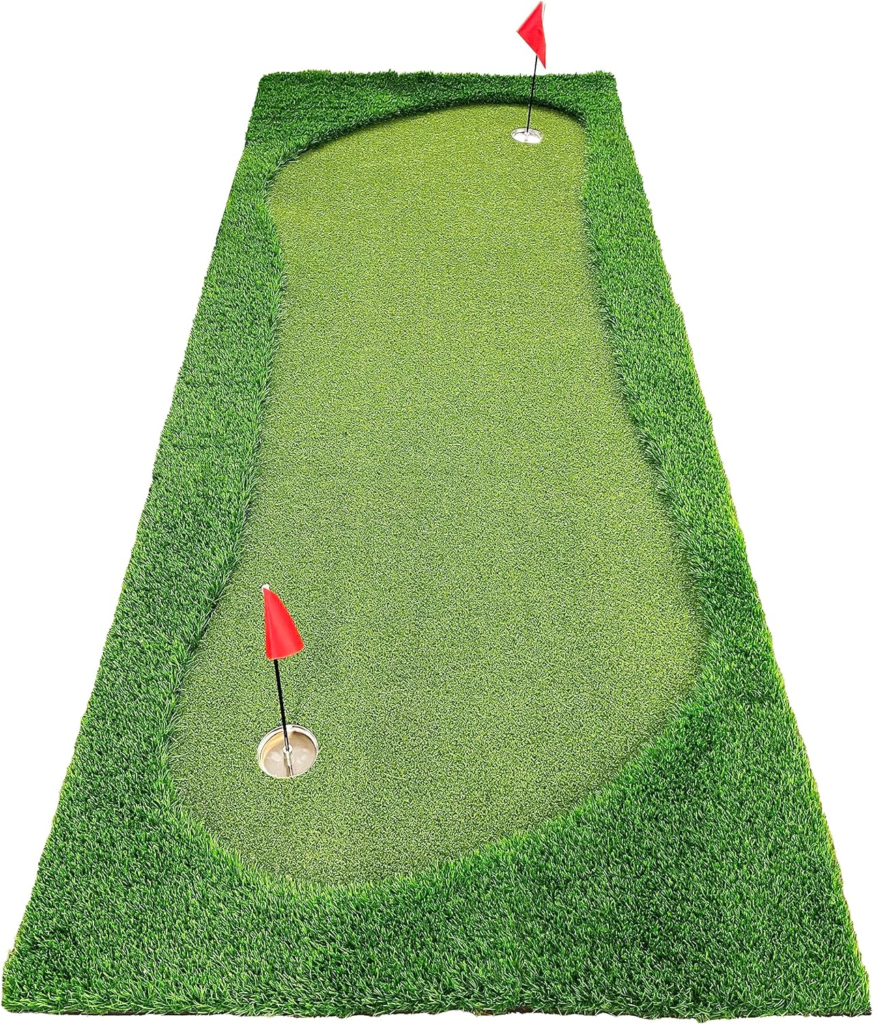
3. Consider Storage Options:
- If storage space is a concern, prioritize indoor putting greens that offer easy storage solutions. Roll-out greens are often more convenient in this regard.
We may earn a commission, at no additional cost to you.
4. Research Different Types:
- Explore the pros and cons of modular, roll-out, and custom-built putting greens. Each type has its advantages, and your choice will depend on factors like space, budget, and desired features.
5. Seek Recommendations:
- Reach out to fellow golfers, friends, or golf professionals for recommendations. Personal experiences and insights can be invaluable in making an informed decision.
6. Test Before Purchase:
- If possible, test the putting green before making a purchase. Some golf retailers or indoor golf facilities may have demo setups, allowing you to experience the feel and performance.
7. Check Warranty and Return Policies:
- Ensure that the product comes with a reasonable warranty. Additionally, familiarize yourself with the return policy in case the indoor putting green doesn’t meet your expectations.
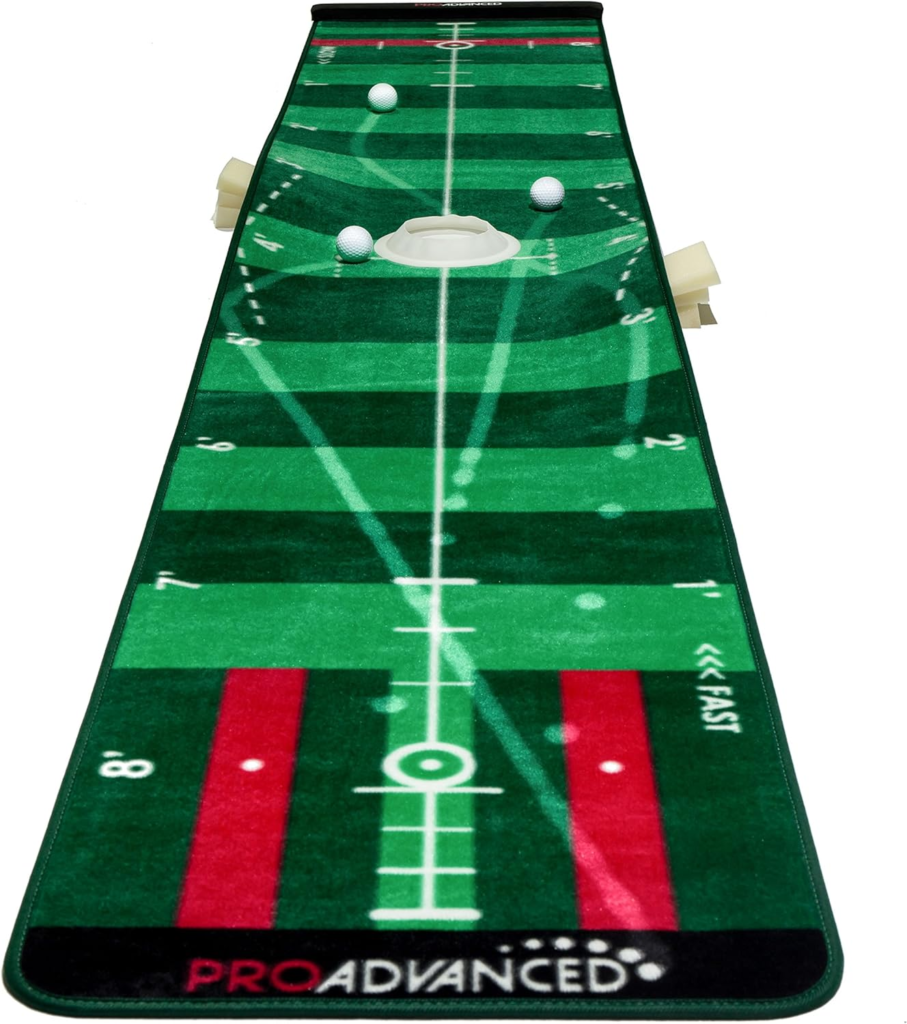
8. Explore Additional Features:
- Some indoor putting greens come with additional features like adjustable breaks, contours, or even simulated hazards. Consider these features based on your skill level and the level of challenge you seek.
We may earn a commission, at no additional cost to you.
Maintaining Your Indoor Putting Green
Once you’ve selected and set up your indoor putting green, proper maintenance is key to ensuring longevity and optimal performance.
1. Regular Cleaning:
- Keep the putting surface clean from dust and debris. Regularly vacuum or brush the turf to maintain a smooth and consistent ball roll.
2. Storage Practices:
- If your indoor putting green is roll-out, follow proper storage practices. Roll it up when not in use and store it in a cool, dry place to prevent damage.
3. Inspect for Wear and Tear:
- Periodically inspect the putting surface for any signs of wear and tear. Address any issues promptly to prevent further damage.
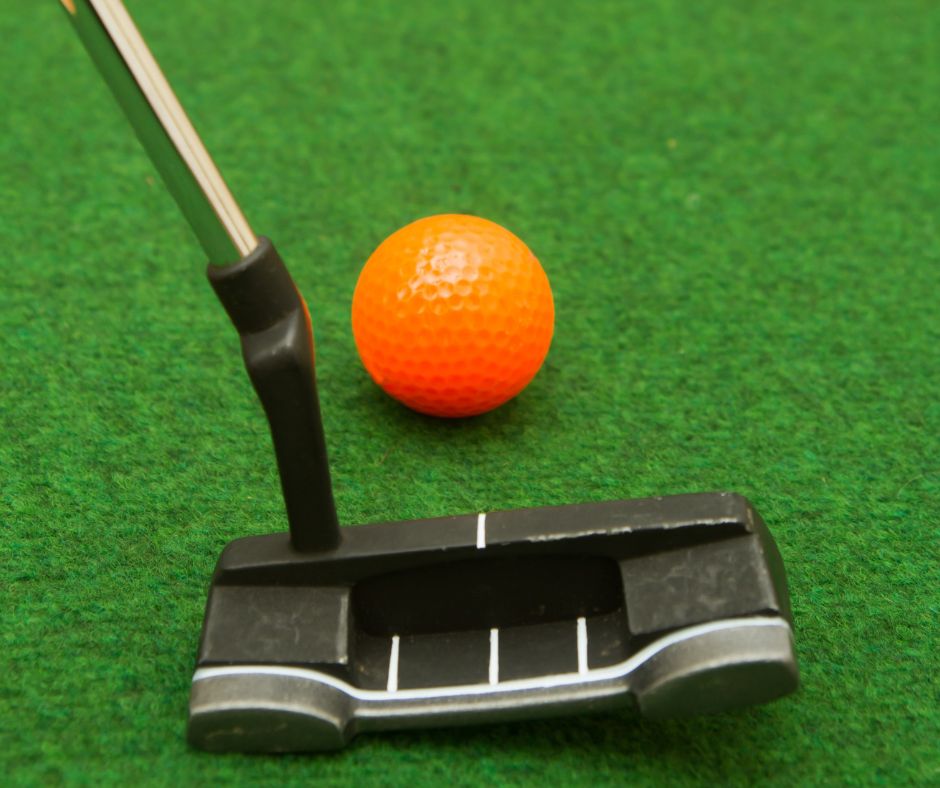
4. Avoid Sharp Objects:
- Keep sharp objects away from the putting surface to prevent cuts or damage. This is particularly important for roll-out greens with a softer backing.
5. Follow Manufacturer Guidelines:
- Adhere to the manufacturer’s guidelines for maintenance and care. This may include specific recommendations for cleaning agents or techniques.
The Benefits for Senior Golfers
For senior golfers, the pursuit of refining and maintaining their golfing skills takes on a unique significance. The convenience of practicing at home becomes paramount, making indoor putting greens an invaluable tool for honing their short game. From addressing physical health considerations to fostering mental well-being and social connection, the path for senior golfers seeking an enhanced and enjoyable golfing experience within the comfort of their homes.
Physical Health Enhancement
1. Low-Impact Exercise:
- Indoor putting greens offer an opportunity for low-impact exercise, allowing senior golfers to maintain joint flexibility and mobility without subjecting themselves to the physical demands of a full round.
2. Balance Improvement:
- The act of putting involves subtle weight shifts and balance adjustments. Regular practice on an indoor green can contribute to improved balance, a crucial aspect of physical well-being for seniors.
3. Joint-Friendly Movement:
- The gentle, repetitive motion of putting is joint-friendly, making it an ideal exercise for seniors looking to engage in golf-related activities without putting excessive strain on their joints.
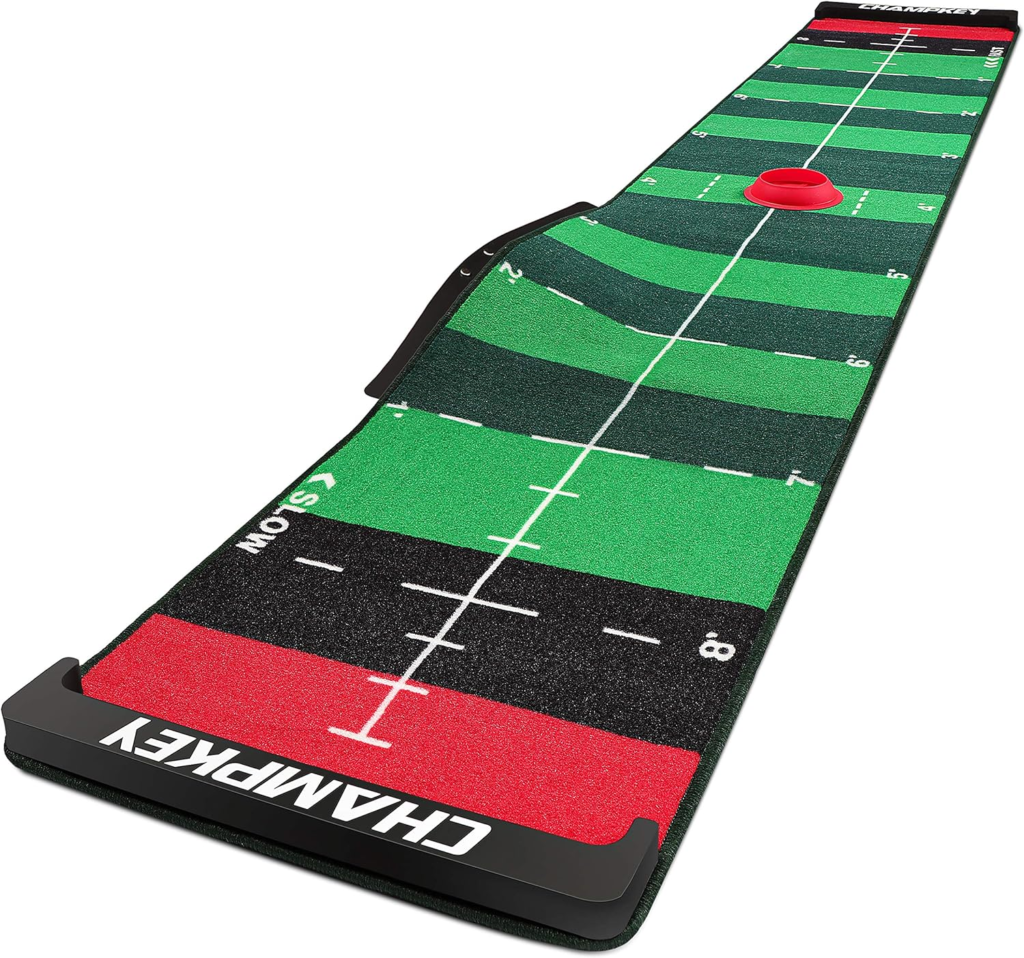
4. Strength Maintenance:
- The act of swinging the putter and walking around the indoor green naturally engages muscle groups, helping senior golfers maintain strength, particularly in the core, legs, and arms.
We may earn a commission, at no additional cost to you.
5. Consistent Physical Activity:
- Having an indoor putting green ensures consistent physical activity, promoting overall health and contributing to an active lifestyle for senior golfers.
Mental and Emotional Well-being
1. Stress Reduction:
- The serene environment created by an indoor putting green, coupled with the focus required for putting, provides a therapeutic space for stress reduction, enhancing mental well-being.
2. Cognitive Stimulation:
- The strategic elements of putting, including assessing distances, planning shots, and reading breaks, stimulate cognitive functions. For senior golfers, this mental engagement is vital for maintaining cognitive health.
3. Sense of Accomplishment:
- Successfully sinking putts on an indoor green instills a sense of accomplishment. For seniors, these small victories contribute to a positive self-image and a feeling of vitality.

4. Enjoyment and Relaxation:
- Golf, even in the form of putting indoors, provides enjoyment and relaxation. Senior golfers can savor the pleasure of the game without the need to travel to a golf course, fostering a sense of joy in their daily routine.
Social Connection and Community
1. Home-Based Socializing:
- Indoor putting greens offer a space for socializing at home. Senior golfers can invite friends or family members to join them for a friendly putting session, fostering social connections.
2. Virtual Community Engagement:
- Participating in online communities or forums related to indoor putting greens allows senior golfers to connect with like-minded individuals, share experiences, and exchange tips and recommendations.
3. Family Bonding:
- Incorporating indoor putting into family activities creates opportunities for intergenerational bonding. Grandchildren and family members can join in, making it a shared experience for all.
Conclusion
In conclusion, selecting the perfect indoor putting green involves a thoughtful evaluation of your needs, preferences, and available space. Whether you opt for a modular system, a roll-out green, or a custom-built masterpiece, the key is to prioritize quality, consistency, and features that align with your practice goals. With the right indoor putting green, you can hone your putting skills, enjoy the convenience of practicing at home, and elevate your overall golfing experience. So, embark on this journey with confidence, compare wisely, and roll those putts into the heart of the cup from the comfort of your own indoor oasis.

Putting Drills & Tips
Golf Lessons For The Flat Stick by Golf Distillery
In this section of the site, we’ll focus on what I truly believe is the most important club in the bag… the putter.
The putting tips and lessons below cover good putting fundamentals such as alignment and stance, the putting stroke, the putting grip, reading greens and distance control. I’ve also included some putting drills and games so that you can make the most of your time when you practice putting.

How Many Putts Do You Take?
I don’t think most golfers appreciate just how many shots they are throwing away with their putter. If you want to better your scores on the golf course and lower your handicap as quickly as possible – improve your putting.
- Count the number of putts you take per round over an average of 3 rounds.
- If you’re taking more than 36 putts per round, you’re wasting shots on the golf course.
- If, like many higher handicappers, you’re taking 40+ putts per round, it’s like taking half a dozen air shots on the first tee. You wouldn’t do that too often before doing something about it!
- There’s no reason why any level of golfer can’t become a very good putter with proper instruction and a bit of practice.
- Unlike the physically demanding full swing, putting is a skill that can be mastered regardless of age and physical strength.
Lag Putting Drill
2-Putt everything from anywhere on the green
The distance from the hole for your first putt is always determined by the quality of your approach.
Sure, you will sometimes be able to put your ball within 10 feet for a real chance at birdie. But more often than not you will be faced with putt distances where the odds are against you. Instead of going for it every time it may be best to take your medicine and protect your par from a three-putt bogey rather than going for the one-putt birdie.

Follow these steps to practice your lag putting:
- If at all possible position yourself far away from three different holes on the putting green and drop three balls in front of you.
- Strike your first ball towards one of the holes while trying to see the ball coming to rest within three feet of the hole. This circle around the hole is the target, not the hole itself so the pace of the putt is more important than the precise line.
- Strike your second ball towards a second hole with the same objective of seeing the ball come to rest close to the hole.
- Finally, strike your third ball towards the last hole, again with the same objective.
- Go to your first ball and try to hole it in what would be a two-putt par. Likewise, try to convert your second and third ball and see how many three-putts you were able to save.
Target the Very Center of the Cup Drill
Take dead aim… at the very center of the hole
Harvey Penick used to say that golfers should take dead aim. While he may have been talking about golf shots using longer clubs and full swings that saying can certainly also apply to putting. Indeed, rather than aiming at the general direction of the hole it can be quite useful to aim at the very center of the hole. That way, missing that very precise target can still result in holed putts.

Follow these steps in order to make a precise target in the middle of the hole:
- Plant a tee straight onto the inside of a hole on the practice green.
- Push it through the ground sufficiently so that there is enough room for the ball to fall in the hole should it strike it.
- Practice putting from in front of the tee while trying to see the ball hitting the tee before falling into the hole.
Alternative
If you want to make sure not to damage the inside of the cup as prescribed or if there is a hard plastic liner preventing you from doing so there is an easy alternative. Indeed, practice your putting as you normally would on the putting green but instead of aiming at the holes simply aim at a tee (or tees) that you previously inserted into the ground. Imagine that you must hit the tee in order for the putt to count as made. Any putt that missed the tee can be deemed not to fall in.
The Smaller the Target the Greater the Margin of Error
Performing this putting drill will train you to focus and aim at a very specific target. This is in contrast to aiming at the general direction of the hole. Picking a smaller target will get you to really apply yourself to make sure you hit a great putt and that the line you picked was the correct one.
And best of all, when you take that focus onto the golf course and when you miss that small target your putts may still fall into the hole nonetheless.
- Mental Strategies to Help Senior Golfers Play Better
 ⛳️ Golf is more than a swing—it’s a mental game. For senior golfers, sharpening your focus, building confidence, and staying calm under pressure can make all the difference.
⛳️ Golf is more than a swing—it’s a mental game. For senior golfers, sharpening your focus, building confidence, and staying calm under pressure can make all the difference. - Golf Spectator Etiquette: How to Enjoy the Game Without Distracting the Pros (With Lessons from the 2025 Ryder Cup)
 Learn golf spectator etiquette with senior-friendly tips. Lessons from the 2025 Ryder Cup show why respect keeps the game enjoyable.
Learn golf spectator etiquette with senior-friendly tips. Lessons from the 2025 Ryder Cup show why respect keeps the game enjoyable. - Forward Tees: The Distinction of Being a Super Senior
 Experiencing something peculiar and delightful has been my reality in recent years. It’s been quite a transformation for me—I’ve become what they call a “super senior” golfer. Now, let me clarify,
Experiencing something peculiar and delightful has been my reality in recent years. It’s been quite a transformation for me—I’ve become what they call a “super senior” golfer. Now, let me clarify, - Best Golf Tips for Senior Golfers – Expanded Guide
 Whether you’ve been playing golf for decades or have only recently taken up the sport, being a senior golfer comes with its own set of challenges and opportunities.
Whether you’ve been playing golf for decades or have only recently taken up the sport, being a senior golfer comes with its own set of challenges and opportunities. - Effective Ways to Address Smoking on the Golf Course
 Smoking—especially cigar smoking—on the golf course is a long-standing tradition for some players, but it can also create tension within a group when not everyone enjoys or tolerates smoke. Addressing smokers in your group the right way requires a balance of respect, tact, and awareness of both etiquette and course policies. Smoking on the Golf… Read more: Effective Ways to Address Smoking on the Golf Course
Smoking—especially cigar smoking—on the golf course is a long-standing tradition for some players, but it can also create tension within a group when not everyone enjoys or tolerates smoke. Addressing smokers in your group the right way requires a balance of respect, tact, and awareness of both etiquette and course policies. Smoking on the Golf… Read more: Effective Ways to Address Smoking on the Golf Course
